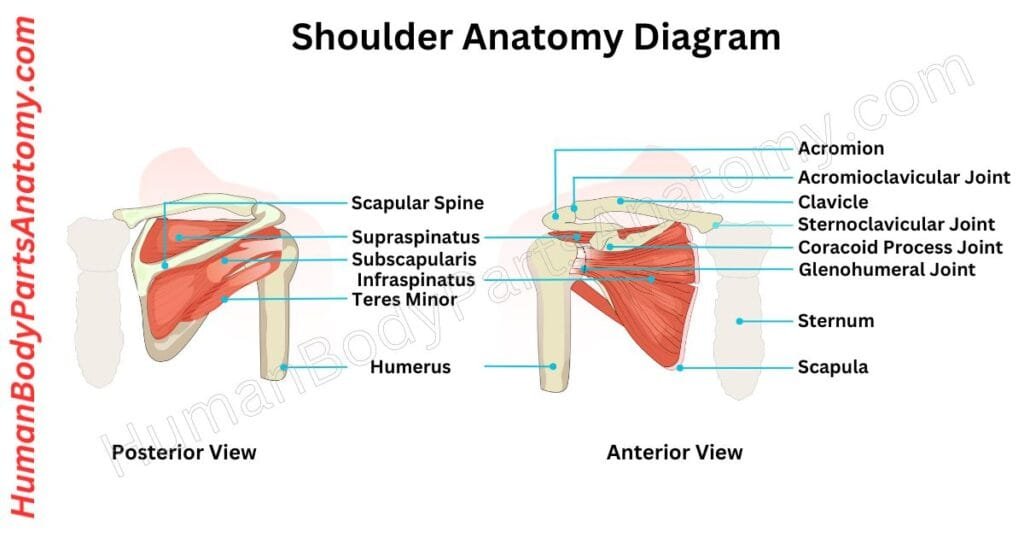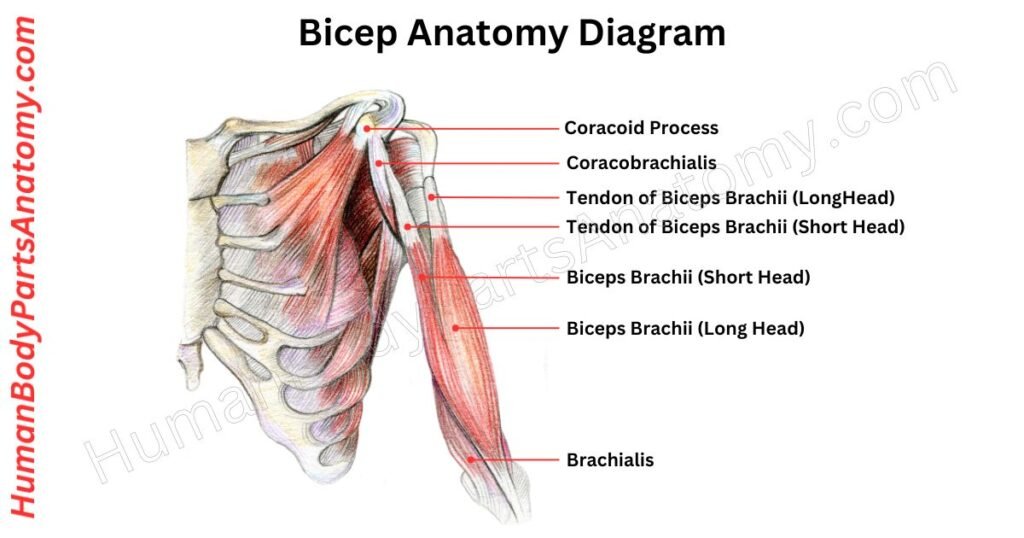Overview of Shoulder Anatomy
The human shoulder anatomy has three bones: the collarbone, shoulder blade, and upper arm bone. These bones are connected by joints, with the main one being the shoulder joint or glenohumeral joint. Other joints, like the acromioclavicular joint, are also part of the shoulder. The shoulder joint allows circular rotation and lifting of the arm away from the body. It is like a ball sitting in a socket formed by the shoulder blade. There’s a soft tissue envelope called the joint capsule surrounding the shoulder joint, lined with a smooth synovial membrane.
A group of four muscles maintains the shoulder’s stability, called the rotator cuff. These muscles attach to the shoulder blade and the upper arm bone. They are the supraspinatus, subscapularis, infraspinatus, and teres minor.
Shoulder Anatomy Diagram

Parts of a Shoulder
Bones
- Scapula (Shoulder Blade)
- Clavicle (Collarbone)
- Humerus (Upper Arm Bone)
Joints
- Glenohumeral Joint
- Acromioclavicular Joint
- Sternoclavicular Joint
Muscles
- Deltoid
- Rotator Cuff Muscles
- Biceps Brachii
- Triceps Brachii
Ligaments
- Glenohumeral Ligaments
- Coracohumeral Ligament
- Transverse Humeral Ligament
- Coracoacromial Ligament
Tendons
- Rotator Cuff Tendons
- Biceps Tendon
- Deltoid Tendon
- Long Head of Triceps Tendon
Bursae
- Subacromial
- Subscapular
Shoulder Anatomy Bones
Scapula (Shoulder Blade)
The scapula, or shoulder blade, is a flat triangle bone at the back of your body. It sits over ribs two to seven. It forms the shoulder girdle with the clavicle and the sternum’s manubrium, linking your arm to your body’s core.
The scapula is crucial because many arm and shoulder muscles attach to it. It also connects to the humerus and clavicle to form the shoulder and acromioclavicular joints.
The scapula is not directly fixed to your body; instead, muscles hold it in place. It allows it to move along your back (scapulothoracic joint), giving your arm a wide range of motion compared to your leg.
Clavicle (Collarbone)
The clavicle is a long, S-shaped bone that runs horizontally across the top portion of your rib cage. It helps to link your sternum to your shoulder blade.
It measures about 6 inches long and goes down the top of your chest. Ligaments attach to your sternum and shoulder blade. The clavicle provides upper-body support and allows your shoulders to move freely.
It functions like a brace, shifting weight from your arms to your core. Overall, it is an essential component of your skeletal system. It assists in everyday activities and maintains shoulder stability.
Humerus (Upper Arm Bone)
The humerus is the biggest bone in your upper arm. It has three main parts: the top part, the middle part, and the bottom part. These parts have important bumps and grooves.
At the top, the humerus connects with the shoulder blade, allowing your arm to move at the shoulder. At the bottom, it connects with the two bones in your forearm, allowing your arm to bend and straighten at the elbow.
Your elbow joint is special because it lets you do things like turning your palm up (supination) or down (pronation), which you can’t do with other parts of your body.
Shoulder Anatomy Joints
Glenohumeral Joint/ Shoulder Joint
The shoulder joint connects your arm to your body and lets it move in many ways. It is like a ball sitting on a socket, where the ball is the head of your upper arm bone, and the socket is a shallow groove in your shoulder blade.
As it is so flexible, you can move your arm in all directions—up, down, to the side, and in circles. But because it is not very stable, it is easy to injure.
Instead of relying on bones for support, it depends on muscles and ligaments, like the ones in your rotator cuff, to keep it secure.
Acromioclavicular Joint
The AC joint is where the collarbone (clavicle) meets a part of the shoulder blade (scapula). It is a key joint in the shoulder, allowing various movements. Unlike other joints, it doesn’t have muscles directly acting on it. Hence, its movements are passive.
This joint can move in three main ways: forward-backward (protraction-retraction), up-down (elevation-depression), and rotation.
Its main job is to help the shoulder blade follow the movements of the shoulder joint once the sternoclavicular joint has reached its limit. Also, it helps transfer forces from the arm to the collarbone.
Sternoclavicular Joint
The sternoclavicular joint connects the sternum (breastbone) with the clavicles (collarbones). It has a direct link between the upper limb and the trunk. This joint allows the upper limb to move freely alongside the body’s core.
The joint has three main movements: up-down, front-back, and rotation. These movements help the arm to move in various directions.
The brachiocephalic artery, jugular vein, and carotid artery are all significant structures around the joint.
In addition to facilitating arm motions, the sternoclavicular joint safeguards important tissues that enter the chest.`
Shoulder Anatomy Muscles
Deltoid
The deltoid is a powerful, triangular muscle in the shoulder. It attaches to your collarbone, shoulder blade, and spine before connecting to your upper arm.
It is made up of three parts: the acromial (in the center) lifts your arm to the side, the clavicular (in the front) bends and rotates your arm inward, and the scapular spinal (in the back) extends and rotates your arm outwards.
Overall, the deltoid muscle allows you to move your arm in multiple directions while keeping it steady during motions like lifting and reaching.
Rotator Cuff Muscle
The rotator cuff is a group of muscles and tendons in your shoulder that help you move your arm. In each shoulder, we have 1 rotor cuff muscle.
They connect your shoulder blade to your upper arm bone. It is like rubber bands holding things together. When you lift your arm or rotate it, they help keep everything stable.
Your shoulder works like a ball and socket, with the upper arm bone fitting into a socket in your shoulder blade.
Biceps Brachii
The biceps muscle in the upper arm helps bend the arm at the elbow and turn the palm upward. It is made up of two parts: the long and short heads, starting from the shoulder blade and joining together to connect to the upper forearm.
This muscle is important for activities like lifting and holding things. When we bend our arm at the elbow, it is called forearm flexion.

Read More – Ultimate Guide to Bicep Anatomy: Parts, Names, Functions & Diagram
Triceps Brachii
The triceps brachii is a muscle in the upper limb that helps straighten your arm. It has three parts: the inside, the outside, and the long parts. These muscles start from your upper arm bone and shoulder blade.
When you straighten your arm at the elbow, your triceps brachii is at work. Additionally, the long part also helps move your arm closer to your body at the shoulder.
Shoulder Anatomy Ligaments
Glenohumeral Ligament
The shoulder has three important ligaments called the glenohumeral ligaments. They work together to make a capsule that connects the shoulder socket (glenoid fossa) to the upper arm bone (humerus).
These ligaments—superior, middle, and inferior—keep the shoulder stable and stop it from dislocating forward. So basically, they guard your shoulder, keeping it safe and secure.
Coracoclavicular Ligament
The coracoclavicular ligament is a tough band that holds the acromioclavicular (AC) joint together. It has two parts: the conoid part at the back and the trapezoid part at the front.
Both parts attach to the clavicle and merge at the coracoid process of the scapula. A cushioning sac often separates them called a bursa.
This ligament acts like a rope, supporting the shoulder blade and arm by hanging them from the collarbone. It also helps keep the AC joint stable, preventing the shoulder from popping out of place upwards or rotating too much.
They are also allowing smooth movements like pulling the shoulder blades back or forward.
Coracoacromial Ligament
The coracoacromial ligament is a sturdy triangular band linking the coracoid process to the acromion, protecting the shoulder joint.
Positioned above the collarbone and beneath the deltoid muscle, it shields the joint like a triangle-shaped shield. This ligament consists of two robust bands attaching to the coracoid process and the acromion, connected by a thinner middle section.
It works alongside the supraspinatus tendon, separated by a bursa, to support shoulder movement.
Transverse Humeral Ligament
The Transverse Humeral Ligament is like a band that goes from one bump to another on your upper arm bone. It turns a groove into a canal.
Read More-
Lower Limb
- Complete Guide to Thigh Muscle Anatomy: Learn Parts, Names & Diagram
- Complete Guide on Leg Anatomy with Parts, Functions & Diagram
- Knee Anatomy: Complete Guide to Parts, Names, Functions & Diagram
- Femur Anatomy: Complete Guide with Parts, Names, Functions & Diagram
Upper Limb
- Comprehensive Guide to Arm Anatomy: Parts, Names & Diagram
- Complete Guide to Hand Anatomy: Parts, Functions & Diagram
- Ultimate Guide to Bicep Anatomy: Parts, Names, Functions & Diagram
- Complete Guide to Finger Anatomy with Parts, Names, Functions & Diagram
- Shoulder Anatomy: Ultimate Guide to Parts, Names, Functions & Diagram
- Wrist Anatomy: Ultimate Guide to Parts, Names, Functions & Diagram
- Complete Guide to Nail Anatomy with all Parts, Names & Diagrams
Human Head
- Ultimate Guide to Eye Anatomy: Parts, Structure, Functions & Diagram
- Ultimate Guide to Ear Anatomy: Parts, Structure, Functions & Diagram
- Tongue Anatomy: Complete Guide with Parts, Names, Functions & Diagram
- Mouth Anatomy: Complete Guide with Parts, Names, Functions & Diagram
- Complete Guide to Tooth Anatomy: Learn Parts, Names & Diagram
External Sources-
- Wikipedia
- KenHub
- Optometrists
- Cleveland Clinic
- American Academy of Ophthalmology

